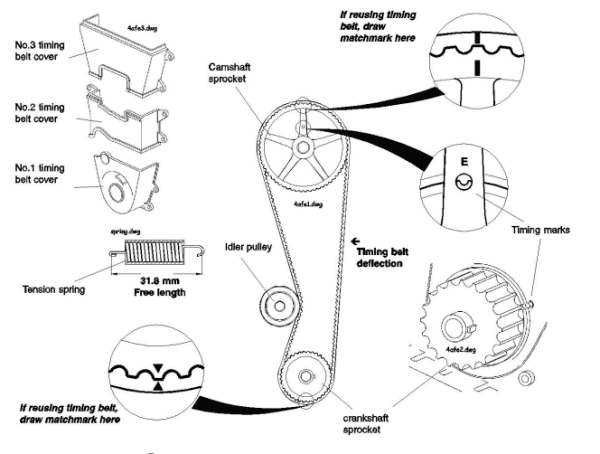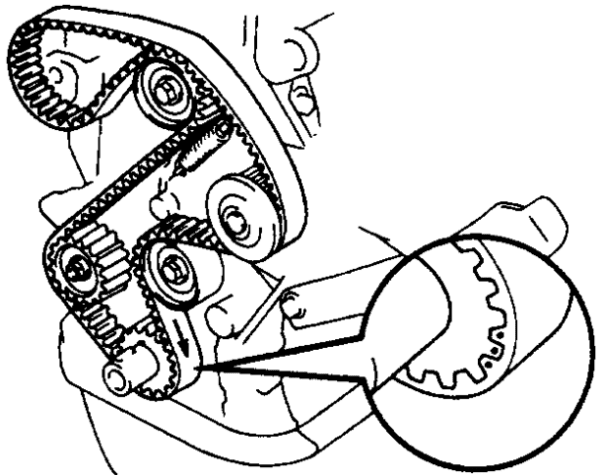Toyota 1ZZ timing marks – Toyota 3ZZ timing marks

Absolutely! Here’s a detailed breakdown of the Toyota 1ZZ-FE and 3ZZ-FE engine timing, covering everything from timing components, procedures, and differences, to signs of timing issues—written in over 600 words.
Toyota 1ZZ-FE and 3ZZ-FE Engine Timing: Complete Overview
Introduction to the ZZ Engine Family
The Toyota ZZ engine family includes a series of inline-4 DOHC engines known for their balance of fuel efficiency and reliability. Two popular members of this family are the:
- 1ZZ-FE: 1.8L, used in Corolla, Celica, Matrix, MR2 Spyder, etc.
- 3ZZ-FE: 1.6L, primarily seen in international market Toyota Corolla, Avensis, and Allex.
Both engines share similar architecture, including aluminum blocks and heads, DOHC 16-valve setups, and timing chain-driven camshafts, which offer long service life compared to timing belts.
Basic Engine Specs (for context)
| Feature | 1ZZ-FE | 3ZZ-FE |
|---|---|---|
| Displacement | 1.8L (1794 cc) | 1.6L (1598 cc) |
| Bore x Stroke | 79.0 mm x 91.5 mm | 79.0 mm x 81.5 mm |
| Timing Mechanism | Single roller timing chain | Single roller timing chain |
| VVT-i | Yes (intake only, in most models) | Yes (intake only) |
| Lifespan of chain | Often exceeds 200,000 km (124,000 mi) | Similar durability |
Timing Chain vs Timing Belt
Both the 1ZZ and 3ZZ engines use timing chains instead of belts, which means:
- No regular replacement intervals like belts (typically every 60,000–100,000 miles).
- Chains are lubricated by engine oil, so oil cleanliness is crucial.
- Failure is rare if oil changes are maintained, but possible due to tensioner wear or sludge.
Timing Components and Layout
- Timing Chain
- Timing Chain Tensioner
- Timing Chain Guides (sliders)
- Crankshaft Sprocket
- Camshaft Sprockets (2 cams – intake and exhaust)
- Oil control valve (OCV) for VVT-i
- Camshaft Timing Gear (Intake side VVT-i)
The chain links are color-coded to help align the chain with timing marks during service or rebuild.
Engine Timing Procedure (General)
Here’s a simplified step-by-step outline of setting correct timing on the 1ZZ and 3ZZ engines:
🔧 Preparation
- Disconnect the battery.
- Drain engine oil and coolant if you’re removing the timing cover.
- Remove the valve cover, serpentine belt, and timing chain cover.
🔧 Timing Alignment
- Set piston #1 to TDC (Top Dead Center) on the compression stroke:
- The crankshaft pulley mark should align with the “0” on the timing scale on the timing cover.
- Align the colored links on the timing chain with:
- The dot or groove on the intake camshaft sprocket
- The dot/groove on the exhaust camshaft sprocket
- The mark on the crankshaft sprocket
- Make sure cam lobes on cylinder #1 are in the “outward” position, indicating compression TDC.
🔧 Chain Tensioner
- With timing aligned, install the hydraulic tensioner.
- Manually release it after the chain is in place to maintain tension.
🔧 Final Checks
- Rotate the engine manually 2 full revolutions clockwise and recheck timing marks.
- If marks don’t realign, you’ll need to re-time.
- Install timing cover, valve cover, and accessories.
Timing-Related Symptoms
Even though timing chains last longer than belts, issues may still occur. Common signs of timing problems:
- Rattling noise at startup or idle (loose chain or bad tensioner)
- Check Engine Light (codes like P0010, P0011, P0012 – VVT timing issues)
- Rough idle or poor fuel economy
- Loss of power or misfires
- Chain slap – can damage the timing cover
Common Causes of Timing Failure
- Sludge buildup (especially with infrequent oil changes)
- Worn timing chain guides
- Failed tensioner spring or seal
- Stretched timing chain (rare before 200,000 km)
Maintenance Tips
- Use high-quality oil and change it regularly (every 5,000–8,000 km).
- Avoid using thicker oil than recommended—VVT-i is sensitive to oil viscosity.
- If replacing the tensioner, consider doing guides and chain together if mileage is over 150,000 km.
1ZZ vs 3ZZ Timing Differences
Though both engines share architecture, here are a few minor distinctions:
| Feature | 1ZZ-FE | 3ZZ-FE |
|---|---|---|
| Timing Chain Width | Slightly wider on 1ZZ | Narrower in some versions |
| VVT-i Control | Common on intake only | Intake only; simpler system |
| ECU Control | Varies more in 1ZZ across trims | More standardized |
Conclusion
The Toyota 1ZZ-FE and 3ZZ-FE engines use a timing chain system that is highly reliable, low maintenance, and designed to last the lifetime of the engine. However, regular oil changes, using the right oil grade, and listening for early warning signs of chain wear (like rattling) can prevent costly engine damage.
Timing service on these engines is infrequent but critical when necessary. Whether you’re doing preventive maintenance or rebuilding an engine, aligning timing marks precisely is crucial for engine performance and longevity.
🔧 Helpful Resources
- Toyota ZZ Engine Timing – Workshop PDF via Toyota Tech Info (subscription)
- 1ZZ-FE and 3ZZ-FE Engine Overview – EngineSpecs.net
If you’d like a step-by-step timing chain replacement guide or diagrams for your specific model (e.g., Corolla, Matrix, MR2), let me know your year and trim, and I’ll customize one for you.



